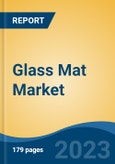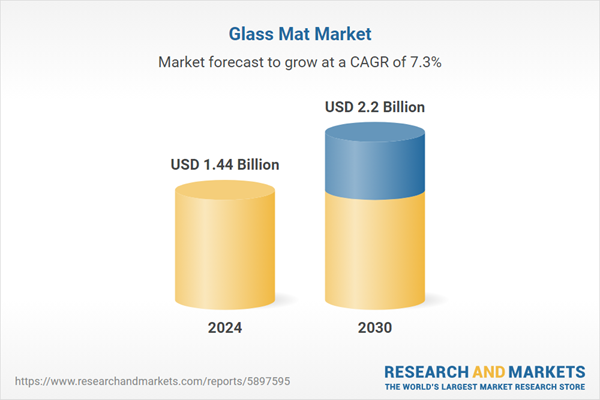Speak directly to the analyst to clarify any post sales queries you may have.
10% Free customizationThis report comes with 10% free customization, enabling you to add data that meets your specific business needs.
Key Market Drivers
Growing Demand of Glass Mat in Construction Industry
The construction sector is a major contributor to the growing demand for glass mats due to their superior performance characteristics. These mats are composed of silica-based glass fibers bonded with binders, creating a durable and resilient material. Their high resistance to moisture, fire, and mold makes them ideal for use in roofing systems, drywall tapes, flooring reinforcement, wall insulation, and waterproofing applications. As construction standards continue to evolve to emphasize longevity, safety, and efficiency, the use of glass mats is becoming increasingly integral to modern building materials.Key Market Challenges
Volatility in Prices of Raw Materials
A critical challenge in the glass mat market lies in the unpredictable nature of raw material costs. The production of glass mats requires glass fibers and resins, both of which are subject to global supply chain fluctuations, commodity market variations, and regional sourcing constraints. These price instabilities affect manufacturers’ production costs, potentially impacting profit margins. In efforts to maintain profitability, some producers may pass these costs on to consumers, which can hinder adoption in cost-sensitive markets and industries where budget constraints are a major consideration.Key Market Trends
Innovations in Binder Technology
The evolution of binder technologies is significantly influencing the glass mat market. Binders are crucial for holding glass fibers together, determining the mechanical and chemical properties of the mat. Traditionally, formaldehyde-based resins dominated the industry, but rising environmental and regulatory pressures have led to the development of low-emission, eco-friendly alternatives. These new-generation binders enhance performance attributes such as flexibility, moisture resistance, and fire retardancy, while aligning with sustainability and health standards, thereby expanding their use across diverse industrial and residential applications.Key Market Players
- Owens Corning
- Binani Industries Ltd
- Saint-Gobain ADFORS
- TAIWAN GLASS IND. CORP
- Nippon Electric Glass Co. Ltd.
- China Beihai Fiberglass Co. Ltd.
- Jiangsu Changhai Composite Materials Co. Ltd.
- John Manville Corp.
- KROSGLASS SA
- Sisecam Dis Ticaret AS
Report Scope:
In this report, the Global Glass Mat Market has been segmented into the following categories, in addition to the industry trends which have also been detailed below:Glass Mat Market, By Type:
- Chopped Strand Mat
- Continuous Filament Mat
Glass Mat Market, By Application:
- Drywall Tape & Accessories
- Flooring Enforcement
- Wall Reinforcement
- Roofing & Waterproofing
- Insulation
Glass Mat Market, By End User:
- Construction & Infrastructure
- Automotive
- Industrial & Chemical
- Marine
- Others
Glass Mat Market, By Region:
- North America
- United States
- Canada
- Mexico
- Europe
- France
- United Kingdom
- Italy
- Germany
- Spain
- Asia-Pacific
- China
- India
- Japan
- Australia
- South Korea
- South America
- Brazil
- Argentina
- Colombia
- Middle East & Africa
- South Africa
- Saudi Arabia
- UAE
Competitive Landscape
Company Profiles: Detailed analysis of the major companies present in the Global Glass Mat Market.Available Customizations:
With the given market data, the publisher offers customizations according to a company's specific needs. The following customization options are available for the report.Company Information
- Detailed analysis and profiling of additional market players (up to five).
This product will be delivered within 1-3 business days.
Table of Contents
Companies Mentioned
- Owens Corning
- Binani Industries Ltd
- Saint-Gobain ADFORS
- TAIWAN GLASS IND. CORP
- Nippon Electric Glass Co. Ltd.
- China Beihai Fiberglass Co. Ltd.
- Jiangsu Changhai Composite Materials Co. Ltd.
- John Manville Corp.
- KROSGLASS SA
- Sisecam Dis Ticaret AS
Table Information
| Report Attribute | Details |
|---|---|
| No. of Pages | 180 |
| Published | July 2025 |
| Forecast Period | 2024 - 2030 |
| Estimated Market Value ( USD | $ 1.44 Billion |
| Forecasted Market Value ( USD | $ 2.2 Billion |
| Compound Annual Growth Rate | 7.2% |
| Regions Covered | Global |
| No. of Companies Mentioned | 10 |









